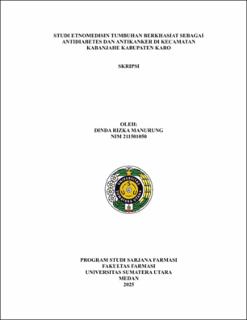| dc.description.abstract | Background: Type 2 diabetes mellitus and cancer are major global health issues with high incidence rates, including in Indonesia. In Kabanjahe District, Karo Regency, still has abundant natural resources and has traditionally used various plants as traditional medicine. Objectives: To inventory the names, therapeutic uses, plant parts utilized, preparation methods, dosage guidelines, and associated conditions or restrictions of medicinal plants traditionally used for antidiabetic and anticancer purposes, and to evaluate the potential profiles of these species in Kabanjahe District, Karo Regency. Methods: This study used a qualitative descriptive research method and was conducted from October to December 2024. Data were collected through semi-structured interviews, with informants selected using purposive and snowball sampling techniques. Data analysis using descriptive qualitative methods using tables and brief explanations. The assessment of the usefulness of medicinal plants was processed using three parameters, namely Use Value Index (UVI), Relative Frequency of Citation (RFC), and Informant Consensus Factor (ICS). Result: A total of 107 medicinal plant species from 47 families were identified in the use of traditional herbal medicine by the community in Kabanjahe District, Karo Regency. The most frequently used plant families for antidiabetic purposes were Zingiberaceae, Lamiaceae, and Asteraceae, while Zingiberaceae was the most commonly used family for anticancer purposes. Leaves, stems, and rhizomes were the most commonly utilized parts. The most common ways of processing plants are boiled, mashed, and squeezed. The most common rule of use is drinking. The Use Value Index (UVI) ranged from 1 to 2.5. The Relative Frequency of Citation (RFC) ranged from 0.009 to 0.057 for antidiabetic plants and from 0.009 to 0.048 for anticancer plants. The Informant Consensus Factor (ICF) ranged from 6 to 20 for antidiabetic use and from 6 to 32 for anticancer use. Conclusion: The use of medicinal plants with antidiabetic and anticancer properties in Kabanjahe District, Karo Regency, involved 107 species from 47 plant families, with Zingiberaceae, Lamiaceae, Asteraceae, and Rutaceae being the most represented. Leaves were the most commonly used plant part, while boiling and grinding were the main methods of preparation and the plants were most commonly used by drinking | en_US |


